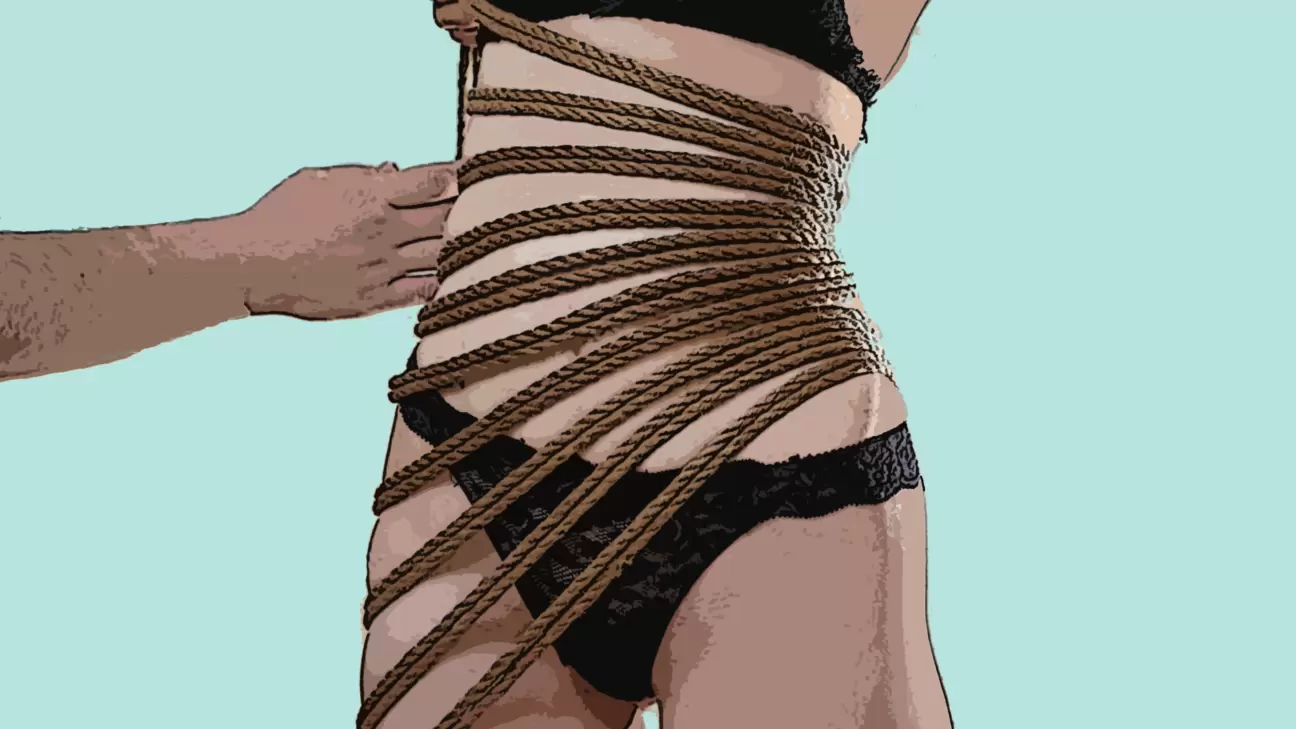Shibari And Why You Should Know More About It


- Here's What Happened
- Shibari Is An Art
- Learning to Master Shibari As A Beginner
- The Basics
- Busting Some Myths
- To Conclude
One of my friends is really talented. He not only has been a research scholar for the past year but also is a theatre and art enthusiast. I’m talking about him because while he was dabbling in nude arts for a bit, he came across this woman who wanted to show him the art of Shibari. And as I’ve decided to dedicate this article to Shibari, you need to know where I learned about it from.
Rope bondage can be fascinating, to begin with, but this is the first time I was looking at it as a form of art. I’m leaning towards telling you a bit about the history of this Japanese form of rope bondage before moving on to the practice. Shibari or kinbaku was derived from an ancient form of Japanese punishment once. Prisoners were often tied with ropes and cords to be tortured or carried to long distances – this was called hojojutsu. The graver the crime, the more intricate the tying up and torture.
Hojojutsu was a symbolic practice. The intricate rope tying techniques evolved aesthetically under the Japanese underground BDSM scene to reach the stage where it is today. I write articles to let you know about kinks and fetishes, among other things, hoping they’d help you learn something you’ll find interesting. Shibari is something both interesting and appealing. So, I’ll move on to begin this article on rope bondage with this anecdote.
Here’s What Happened…
My friend had been taking pictures of nude men and women for some time. They’d usually decide the meeting place beforehand and discuss some concepts and props based on mutual consent before moving forward with the photo shoot. So this one woman, who he’d found online, tells him that she isn’t into nude photography but if he wants he can photograph her with her partner while they practice Shibari.
Now, my friend might be into BDSM but he had never been invited to watch something before. Voyeurism, with consent, wasn’t one of his fetishes either. But since there was also the invitation to click pictures, he agreed to visit the studio where they were supposed to meet. The next hour or so was to be an important step for him as an artist.
He was there, as an audience capturing the moments, without interrupting the participants, fully in the moment…watching as an artist would. Before he could realize the hour was up. He told us later he was so engrossed in the act he didn’t realize halfway through he wasn’t taking all the thought-out pictures. He was just there, trying to understand what it feels like to completely relinquish control before having it all back.
Shibari Is An Art…
One of the participants, the woman, was married and had a daughter, her partner in Shibari was someone she had known for some time and was comfortable with. And the husband, after a week or so, loved the pictures so much he framed one of them for her!
All the sessions – Shibari or otherwise – that go on between two people are to be discussed before engaging. My friend saw firsthand how much care needs to go into this art and practice of rope bondage. The woman had marks where she had been tied, including her arms, legs, feet, and even the face. And of course, there were safe words and aftercare, among all other things that needed to be kept in mind.
My friend came out with some wonderful shots and probably a once-in-a-lifetime experience. If you are ever able to meet someone who has actually been a part of something like this, they’ll be able to tell you how much patience and practice it needs to master something like Shibari.
So what do we do? You’ve had this interest for a while now, I’m hoping, as you’re here, and you want to know what can be done about it. That’s all well and good, but first and foremost, understand that safety and concern are the two most important pillars of the fetish of rope bondage is standing on. That said, let’s move forward gradually to see what this is all about.
Learning to Master Shibari As A Beginner…
Shibari is a Japanese rope bondage practice. It has now sort of evolved into many branches as well. And there are also other kinds of rope bondage that you can indulge in except Shibari. But that’s basically promoting yourself up from handcuffs and tying knots around your partner’s wrists instead. Shibari in itself is an art that allows you to feel the B for Bondage in BDSM.
I mean yes, you can use all the restraining equipment you can find, but tying a rope yourself is something different altogether. Also, Shibari isn’t just always sexual. People practice it as a form of art, at times relaxation, or as a form of self-expression and even self-care. But then there’s, of course, the BDSM practice of trying up your submissive for sexual gratification.
You’ll more or less have to be a professional rope artist to practice tying up these knots. I’m not kidding, this is some serious business. But I’m also not asking you to quit your job and buy yourself a dozen ropes. You’ll learn gradually, that’s what I’m saying. Articles, YouTube videos together with a will to learn (take a class, I insist) this art is what’ll take you there. Soon enough, you’ll have your own space in your house to call a studio.
The Basics of Shibari…
The first and foremost thing to decide is whether you’d like to tie someone up, or would you like to be tied up. If it’s the latter, it’s not much tough. You’ll find professional rope bondage practitioners who would be willing to indulge in this fetish with you. Some of them may demand some remuneration for this indulgence…some of them might only want you.
If it’s the former though, you have some work cut out for you. If it’s only your partner you want to practice Shibari with, you wouldn’t necessarily have to go get a license for it. Maybe just learning it properly would be enough. Although if you’re taking a proper class, they’ll usually provide you with some kind of certificate or a license on completion.
If it’s not just one but multiple partners you’re looking to practice rope bondage with, being a professional is advised. Taking a class, practicing regularly, and actually opening up a studio for the other participants (you can even print visiting cards if people still do that) is customary.
Get Your Terminologies Right…
There are some related terms that you’ll come frequently in contact with. You will hear these words regularly if you’re going to be in the world of Shibari.
Lab Time: Like I’d been telling you, you need to learn how to do this well before trying out your hands in it. Lab time is basically that time you’re willing to give to learn this art. It could be anything from a few weeks to months or even a year.
Scene time: This is the time you’ll allow yourself to indulge in the practice. You have to decide how much time you want to give to yourself or your partners while engaging in Shibari. And as I’ve mentioned once, make sure the screen time is not more than 20 minutes. But this is, of course, excluding the time you need for preparation and aftercare.
Bottom: The Bottom here is not the character from Shakespeare’s Midsummer Night’s Dream but the person being tied. It could be you or your partner. When you self-tie, you are your own bottom.
Rigger/Top: This is the person who’s doing the tying up. As a rigger or atop it’s your responsibility to make sure the bottom is comfortable and does not end up hurt. You must learn the art of Shibari skillfully to deliver the perfect amalgamation of pleasure and pain to the senses.
Rope Switch: It can often be the case that you’re interested to be both a bottom and a rigger. In that case you’d be a rope switch. You don’t necessarily need to self-tie for this, just find other practitioners who are interested to engage with you!
Suspension: After you’ve tied up the bottom, you can suspend the body off the floor with the techniques you’ve learned. Don’t forget to use proper machinery while suspension. You also need to make sure that there’s a protective pad underneath the suspended body, in case of emergencies.
Floor-Play: Shibari is often practiced without suspension. It’s called floor-play when that happens. The bottom is tied up and remains seated or standing on the floor.
Single Column Tie: You’ll have to learn how to tie a bottom. A single-column tie is a foundation for every tie or knot – think of it as the first step – you need to learn.
Okay, I’ve babbled enough about the boring, yet essential, terminologies and technicalities – it’s always important to get these things done and over with rather sooner than later – now it’s time to hit the section where you actually get to know something about what or how to practice rope bondage.
How Do I Begin?
Let’s just say you’ve bought a rope and are dying to use it. Well, and good, let me tell you – all the technicalities aside – what you need to do and what safety measures to take care of. Know the basics: with ropes, if you’re not a professional yet, keep scissors handy and stay away from necks, private parts, and the head. You could do some serious damage otherwise. And always remember the 20-minute rule.
No body part is ever to be tied up for more than 20 minutes. Being restrained for more than 20 minutes can lead to loss of blood flow to that area, numbness, and even severe pain. Think pins and needles times twenty. Also, let’s not forget the redness of the skin and first-class irritation, followed by itching post rope bondage sessions. The trick is to keep moisturizing your skin after you’re done with your session.
Now that we’re done with the basics, where do we begin? No, I’m not here to tell you how to tie a rope – that’s what you learn in the class you’ll take. And you must do so. I’m here to tell you how to prepare yourself for a Shibari session. This is specifically for people who are into being tied up. Although when two partners are concerned, both of you can do with some of these healthy and helpful tips/advice.
Begin with communication
This is the basic step of all. It’s like the mother of all tips – talk to your partner. A Shibari session can be a lot at times. It’s up to the both of you to communicate what you’re feeling before, in between, and after the session. Don’t be afraid or shy to use safe words. Don’t hesitate to ask for what you need in terms of aftercare – it could be a nice warm bath, some affection, or simply a hug.
Tell your partner what you liked the most or about the areas where you thought they could have been a bit better. Communicate to match your pace with them; it may be gentle or rough, sexual or non-sexual.
Be informed about Shibari:
Read books, articles, and magazines. Talk to people. Find out as much as you can about practicing Shibari. Sit and talk to yourself. Try and get to know why you’re into this form of art. If your partner is interested and is asking you to join them, learn about Shibari before agreeing or disagreeing to practice it.
It’s also very important to find a good teacher. People engage in Shibari for their own reasons. Some want to cherish the loss of control that comes with it. Some want to feel the sense of domination that can also come with it. Make sure your values align with your guide. This way, you’ll be able to realize your true potential for this art.
Realize that it takes time:
The first time should not be rushed – be it Shibari or anything else that needs plenty of preparation. You cannot just look at a YouTube video and be ready with a pair of scissors and a rope. Even five minutes of scene time should come with at least a month of lab time. You don’t want to end up hurting yourself or someone else, do you?
Even after you’ve learned the art of Shibari, find people you trust. Practice this art with people who align with your way of practice. Take consent, communicate to know their limits and boundaries and respect the safe words or gestures. No good will come from rushing into Shibari.
Busting Some Myths…
Well, when it’s edge play there’s always something or the other going around about them that’s not true. Shibari is no exception and you might have some of these things or the other as well. It’s natural to have some concerns, so let’s take a look at some major myths and try and bust them!
Shibari is unsafe!
Sure it is, but so is crossing a road if you’re not looking both ways. What I mean to say is, that you must take the proper and necessary precautions before engaging in anything at all – be it a Japanese rope bondage practice or simply going out for a walk.
Evaluate the risks. If you have a history of heart problems or blood pressure, or if you get headaches, nausea, or feel lightheaded when you’re being suspended, Shibari might not be for you. Although, if you find a proper rigger and maybe walk your doctor through your Shibari routine…something could be worked out, between the three of you.
There are some things that are bound to happen. I’ve already mentioned the redness of the skin, the marks, and the itching – but every single one of them can be taken care of. Come prepared with moisturizer, and a pair of safety scissors and you could even go s step further and choose the most comfortable rope you can for yourself!
Shibari is too violent and often degrading.
It isn’t, actually. There’s no hitting involved. And neither is any exclusive hot wax play. I’m mentioning hot wax because many times participants like to mix suspension in Shibari with some wax play. This is an art combined with BDSM but it entirely depends on the participants to decide what they want in their individual sessions. If you come with a whip and the consent to use it, by all means, it’s up to you.
Speaking as someone who has heard exclusively about how gracefully a whole session of Shibari can be conducted, I’d say it’s the least violent play you could come across. And humiliation and degradation as a play aside, Shibari is not degrading. Rather, it’s empowering to go through something like this and know in itself that you’re capable of it.
To Conclude…
There could be many benefits of Shibari – starting from finding people you trust completely to finding a connection to this art that you can cherish forever. I’d say, if you’re informed, interesting, and ready to learn, Shibari might just be perfect for you!


